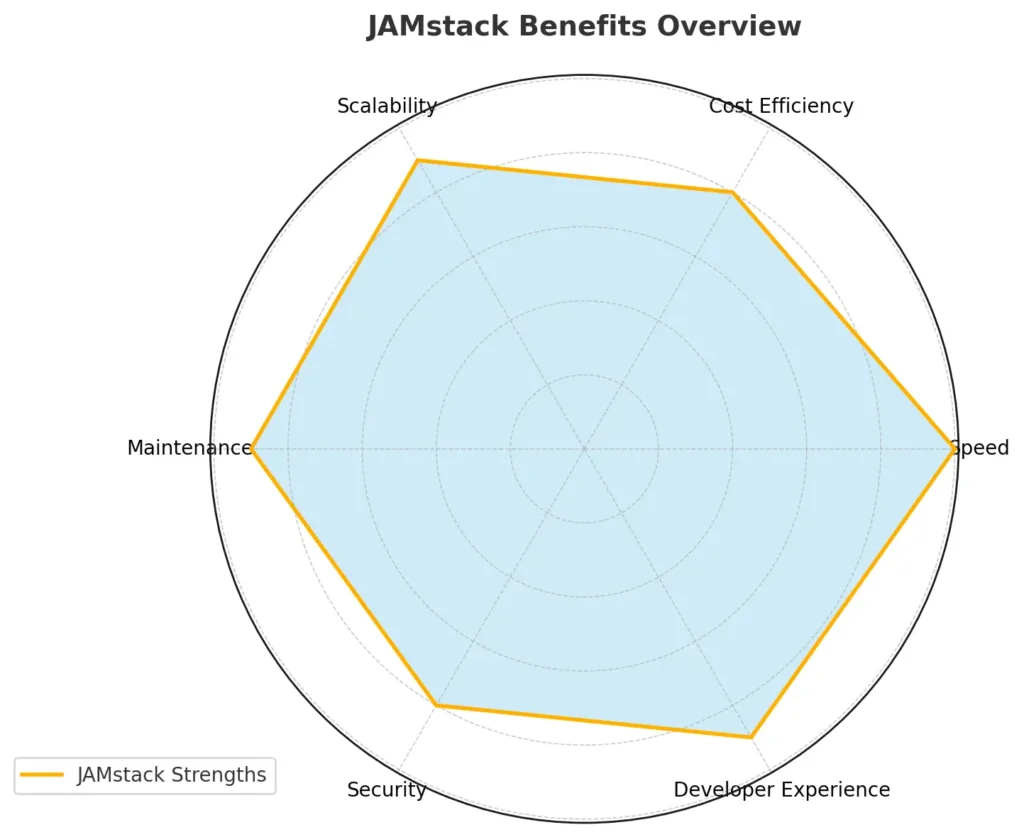To begin with, JAMstack is the idea for a software architecture and philosophy with the following rules: JavaScript, APIs, and Markup. That plain old HTML document that contains no JavaScript, and doesn’t do anything dynamic? Yup, that one is as well a JAMstack app.
What makes up the JAMstack?
The JAMstack is usually made up of 3 main parts: JavaScript, APIs, and Markup. Its history is based on expanding the term “static site” to something more useful (and marketable). And although in the end we have a static site, it’s blown up to have first-class tooling for all the steps along the way.
ImageJAMstack breakdown
There isn’t a specific set of tools that you are required to use, or even tools, apart from basic HTML, but there are excellent things that can make up each part of the stack.
Javascript
The element that has done the greatest effort to make the JAMstack popular is JavaScript. Our favorite browser language makes it possible for us to give all of the dynamic and interactive bits that we might not have when we are doing plain HTML without it.
It is here that many times you will see UI frameworks such as React, Vue, and new kids on the block like Svelte seen to be in use.
They allow building apps in a better structured way by having component APIs and tooling that would compile down to a basic HTML file (or a bunch of them).
Those HTML files contain a set of assets such as images, CSS, and the actual JS, which finally end up being delivered to a client’s browser from your ‘preferred’ CDN (content delivery network).

APIs
Incorporation of the strengths of APIs is fundamental to how you make a JAM stack app dynamic. Whether it is authentication or search, your application will make use of JavaScript to make an HTTP request to any other provider, and at the end of the day, this will enhance the user experience in one way or the other.
Gatsby came up with the term “content mesh,” which does a rather good job of describing the prospects here.
ImageContent Mesh
It is not that you have to connect with a single host for an API; you can connect with as many hosts as you want (but do not get out of hand).
Markup
This is the critical piece. Whether what you write by hand is in HTML or the compiler that produces it down to the HTML, it is the first thing that you are serving to the client. It is rather one of those de facto features of any website, but how you serve it is the most significant piece.
For the application to be considered a part of the JAMstack apps, the HTML should be served statically, which is just some way of saying it won’t be dynamically rendered from a server.
As long as you are stitching a page and passing that page with PHP, that is probably not a JAMstack application. When you put and deliver an individual HTML file from the storage that can create an app using JavaScript, it is just like a JAMstack app.
ImageStatic results delivered from Gatsby in AWS S3.
That doesn’t mean that we should always build 100% of the app inside the browser. Stuff like Gatsby and the other static-site generators allow us to munch on some or all of our API sources at build time and generate the HTML files out of the pages.
In other words, we are going to be in a position to provide a precompiled version of the page right to the browser, which tends to lead to a swifter first paint and expeditious experience for your visitor.
Then, what is so great about a JAMstack app anyway?
The JAMstack apps are, by nature, fulfilling most if not all the 5 pillars of the AWS Well-Architected Framework. These are the basic principles that are embraced by AWS to provide fast, secure, high-performing, resilient, and efficient infrastructure.
Speed
The very fact that you are serving JAMStack apps as static files, directly from a CDN (usually), means that the chances are strong that your app is going to have blazing-fast load times. Those days are past, when it needs the server needed to take time in building pages before responding. Now you serve the page as just plain HTML “as is” or using some type of client-side hydration, such as in the case of React.
Cost
In most cases, JAMstack sites are likely to incur less cost as compared to server-side sites. Serving static assets is cheap, and now your page is also being served at the same rate.
Scalability
Because you are serving your files off a static hosting, probably a CDN, the infinite scalability is pretty much given there. This is the claim that most providers will make; therefore, you will not have a problem allowing any influx of people that will be hitting your site through the front door.

Maintenance
The basement of your static site is not a server, meaning there is no need to take care of it. It does not matter whether it is Netlify, S3, or any other provider; your static HTML, CSS, and JS are stored for you worry-free.
Security
Redoubling upon the lack of server you are forced to physically monitor, you don’t have to care as much about shutting off the method to intrusion.
Instead, you will have to mainly rely on permissions to seal off private content and ensure that your users know that their data is not publicly exposed.
But this is also dependent on your APIs
Even though these points resonate with the static elements of your site, remember that you may still rely on some kind of API for your client-side experience.
Do your best to leverage such requests at compile time, where possible, like with a static site generator. Otherwise, you’ll have to calculate the number of hits you’re doing to a dynamic endpoint and the way it affects all the above aspects of experience for you in general.
Jamstack CMS advantages for developers
Jamstack makes the development of websites easy, but certain benefits that are critical wait for developers. Let us take a glance at some of them:
1. Faster performance
The main advantages of Jamstack include speed. Because web pages do not have to be fetched from an application or a web server and can instead be delivered as pre-built markup and assets via a CDN at speed, this improves the speed and web performance. The result is, thus, reduced loading times and an enhanced user experience.
2. Improved developer experience
The legacy web architectures may limit developers and divert them from the main point, the user experience. It can contribute to the developer’s workload, which reduces their productivity.

3. Increased security
Server-side applications and databases are very vulnerable to cyberattacks. Because Jamstack separates the front-end from the back-end, one gets to encounter fewer chances of being victims of these vulnerabilities.
4. Greater scalability
The fact that there are no server loads to be worried about with a CDN means that it offers much more in scalability and flexibility than a conventional web application.
Conclusion
JAMstack describes an innovative way of web development that focuses on speed, security, and scalability. By decoupling frontend from the backend, using static site generation, APIs, and modern JS frameworks, developers can produce fast, reliable, and maintainable applications. With the increasing need for smooth user experiences, the JAMstack becomes a very strong architecture that accommodates developer needs in addition to business goals. The adoption of JAMstack is not a trend, it is a strategic decision toward the future of the web.





